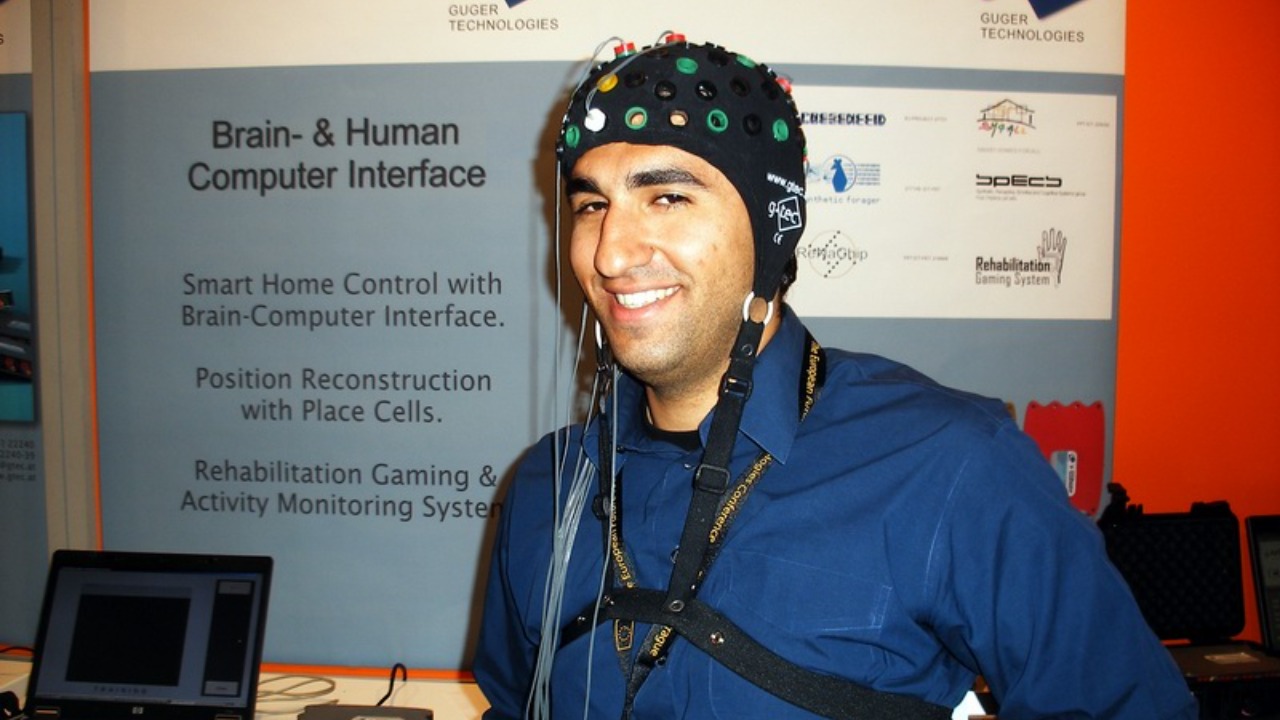
Brain-computer interfaces (BCIs) are emerging as a groundbreaking technology that has the potential to revolutionize the way humans interact with machines. By bridging the gap between human cognition and digital systems, BCIs promise to enhance human capabilities and transform numerous fields, from healthcare to entertainment. However, as we stand on the brink of this technological frontier, it’s crucial to understand both the possibilities and the implications of integrating BCIs into our daily lives.
The Science Behind Brain-Computer Interfaces

Neuroscientific Foundations
At the core of brain-computer interfaces is the ability to harness the brain’s electrical signals to enable direct communication between the brain and external devices. This is achieved by capturing the brain’s electrical activity, often through electroencephalography (EEG), which measures voltage fluctuations resulting from ionic current flows within the neurons of the brain. The captured signals are then translated into commands that can control computers, prosthetic limbs, or other devices. This fascinating interplay between the brain and technology is where the potential of BCIs begins to unfold.
One of the most exciting aspects of BCIs is their ability to leverage neuroplasticity, the brain’s capacity to reorganize itself by forming new neural connections. Neuroplasticity allows BCIs to become more effective over time as the brain adapts to the interface, enhancing the user’s ability to control devices with increasing precision. This adaptability is a cornerstone of BCI technology, promising significant advancements in how these interfaces can be personalized for users.
Technological Developments
Recent advancements in both non-invasive and invasive BCI technologies have propelled the field forward. Non-invasive BCIs, like those utilizing EEG, are becoming increasingly sophisticated, offering improved signal clarity and reduced noise interference. On the other hand, invasive BCIs, which involve surgical implantation of devices directly into the brain, provide greater accuracy and control, albeit with higher risks. A notable example is Neuralink, a company spearheaded by Elon Musk, which is developing high-bandwidth brain-machine interfaces to connect humans and computers more seamlessly.
The role of machine learning and artificial intelligence in BCIs cannot be overstated. These technologies are essential for interpreting the vast amounts of neural data generated by BCIs, translating complex brain signals into actionable commands. Machine learning algorithms are continually improving their ability to decode neural activity, opening up new possibilities for real-time interaction between the brain and external devices.
Transformative Applications of BCIs

Healthcare Innovations
In the realm of healthcare, BCIs hold the potential to significantly improve the quality of life for individuals with disabilities or neurological disorders. For instance, BCIs can enable individuals with spinal cord injuries to regain mobility by controlling prosthetic limbs or wheelchairs with their thoughts. Similarly, BCIs can facilitate communication for individuals with conditions like amyotrophic lateral sclerosis (ALS), allowing them to convey their thoughts without speaking or typing.
Beyond physical rehabilitation, BCIs are making inroads into mental health treatments and cognitive therapies. By providing insights into brain activity patterns, BCIs can assist in diagnosing and treating conditions such as depression, anxiety, and PTSD. Furthermore, BCIs can be used to develop personalized cognitive therapies, offering new avenues for mental health management and intervention.
Enhancing Human Capabilities
BCIs are not only about restoring lost functions but also about enhancing human capabilities. Cognitive enhancement and memory augmentation through BCIs are topics of active research, with the potential to expand human cognitive horizons. Imagine a future where individuals can access vast reservoirs of information and skills directly through their brain-computer interface, radically altering how we learn and process information.
Moreover, BCIs could revolutionize sensory experiences and interactions with virtual reality. By integrating BCIs into VR environments, users can have more immersive and realistic experiences, blurring the lines between the digital and physical worlds. This enhancement of sensory input could lead to novel applications in entertainment, education, and even remote communication.
Ethical and Privacy Concerns

Data Privacy and Security
As BCIs become more integrated into our lives, concerns about data privacy and security are paramount. The neural data collected by BCIs is highly sensitive, containing intimate details about an individual’s thoughts and cognitive processes. Ensuring that this data is securely stored and ethically used is a critical challenge that developers and policymakers must address.
Strategies to protect user privacy include implementing robust encryption protocols and establishing clear guidelines for data usage. Furthermore, it is essential to ensure transparency in how neural data is collected, stored, and shared, fostering trust between users and BCI developers. The RAND Corporation emphasizes the importance of preparing for the ethical challenges that BCIs present.
Ethical Dilemmas
The ethical considerations surrounding cognitive enhancement through BCIs are complex and multifaceted. On one hand, enhancing cognitive abilities could lead to significant societal benefits, such as increased productivity and knowledge acquisition. On the other hand, it raises questions about fairness, accessibility, and societal norms. If cognitive enhancement becomes widespread, it could exacerbate existing inequalities and create new divides between those who have access to BCI enhancements and those who do not.
Another ethical dilemma is the potential loss of agency and dependency on BCIs. As people become more reliant on these interfaces, there is a risk that they may lose touch with their natural cognitive processes and become overly dependent on technology for decision-making. This dependency could have profound implications for individual autonomy and the nature of human-machine relationships.
Regulatory and Societal Challenges

Regulatory Frameworks
The current regulatory landscape for BCIs is still evolving, and there is a pressing need for updated policy frameworks to keep pace with technological advancements. Regulatory bodies must address issues such as safety standards, data privacy, and ethical guidelines to ensure that BCI technologies are developed and deployed responsibly. The U.S. Government Accountability Office has highlighted the need for comprehensive regulatory frameworks to govern the development and use of BCIs.
International efforts to standardize BCI development and deployment are also underway, with organizations and governments collaborating to create harmonized guidelines. These efforts are crucial for fostering innovation while ensuring that BCIs are used safely and ethically across different regions and cultures.
Societal Acceptance
Widespread acceptance of BCIs will depend on how society perceives these technologies and their potential impacts. Public education initiatives are essential to increase understanding of BCIs and dispel myths and misconceptions. By providing accurate information about the benefits and risks of BCIs, these initiatives can help build public trust and acceptance.
Cultural perceptions will also play a significant role in the adoption of BCIs. Different societies may have varying levels of comfort with the idea of integrating technology into the human body. Understanding and respecting these cultural differences will be crucial for successful implementation and acceptance of BCIs on a global scale.
The Future of Brain-Computer Interfaces

Predictions and Possibilities
The future of BCIs holds immense possibilities, with potential impacts across various industries. As technology continues to advance, BCIs could become more accessible and affordable, leading to widespread adoption in both personal and professional settings. We can envision a world where BCIs are seamlessly integrated into our daily lives, enhancing our interaction with machines and each other.
Industries such as healthcare, education, and entertainment stand to benefit significantly from BCI advancements. In healthcare, BCIs could lead to personalized treatment plans and improved patient outcomes. In education, they could revolutionize learning by providing students with direct access to information and resources. In entertainment, BCIs could create more immersive and interactive experiences, transforming how we engage with digital content.
Challenges to Overcome
Despite their potential, BCIs face several challenges that must be addressed to realize their full potential. Technical hurdles, such as improving signal accuracy and reducing invasiveness, are critical areas of ongoing research. Ethical considerations, including data privacy and cognitive enhancement, require careful thought and regulation to ensure responsible development and use of BCIs.
Interdisciplinary collaboration will be essential in advancing BCI research and application. By bringing together experts from neuroscience, engineering, computer science, and ethics, we can address the multifaceted challenges that BCIs present and create a future where these technologies enhance human capabilities while respecting individual rights and societal values.